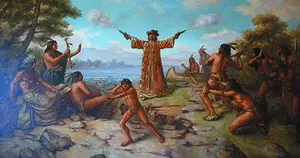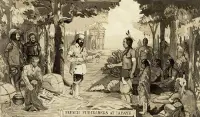The Making of the 50 States: Wisconsin
Part 1: In the Beginning What is now Wisconsin was early home to the Mississippian and Woodland cultures and to the Hopewell and the Effigy Mound Builders. Native American tribes who lived in what is now Wisconsin included the Chippewa, Dakota, Fox, Ho Chunk, Huron, Iowa, Kickapoo, Menominee, Ojibwa, Oneida, Oneota, Potawatomi, and Sauk. 
The first European explorer to appear in what is now Wisconsin was French trader Jean Nicolet, who sailed on Lake Michigan, looking for a Northwest Passage to China, and landed near what is now Green Bay (and to which the French referred to as La Bey) in 1634. A series of armed struggles known as the Beaver Wars forestalled any further French development until the 1650s. A fur trade soon developed, however, and French missionaries followed, establishing a mission at what is now Ashland in 1660. Nicolas Perrot set up a number of trading posts, starting with Green Bay in 1667, and claimed the Wisconsin area for France in 1689. 
The French claim didn't stop English fur traders from moving into the area. Soon, both European powers were competing for control. Like many other states in this part of the country, Wisconsin went from French control to British control after the British victory in the French and Indian War and then from British to American control after the the American victory in the Revolutionary War. As well, Wisconsin, along with Indiana and Illinois and Michigan and Ohio, was part of the Northwest Ordinance, the 1787 land deal that created the Northwest Territory. In 1791, two African-Americans set up a trading post at what is now Marinette. A number of white English settlers were there already, and more soon followed. The Siege of Prairie du Chien, a British victory in July 1814, was the lone Wisconsin battle in the War of 1812. After the Treaty of Ghent that ended the war in 1815, British troops burned the fort rather than hand it back to the Americans. The U.S. Army built Fort Crawford and Fort Howard the following year. The fur trade was big business in the early 19th Century, particularly in Fort Winnebago, Green Bay, and Prairie du Chien. Frenchman John DuBay was a major part of this fur trade for much of Wisconsin's early existence. Next page > The Rest of the Story > Page 1, 2 |
|
Social Studies for Kids
copyright 2002–2024
David White




